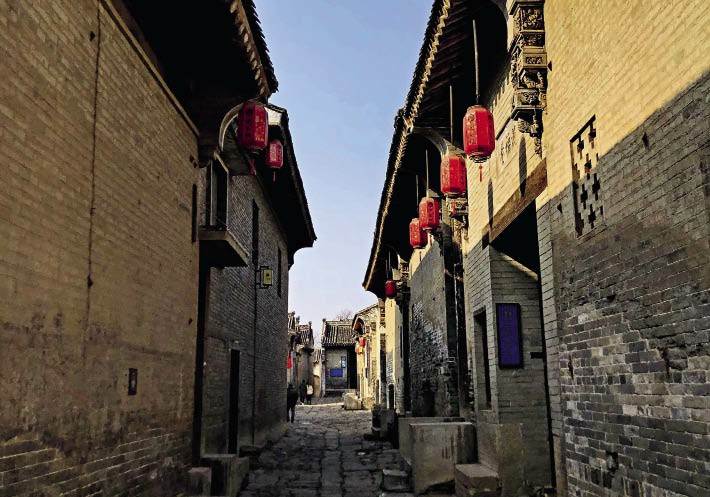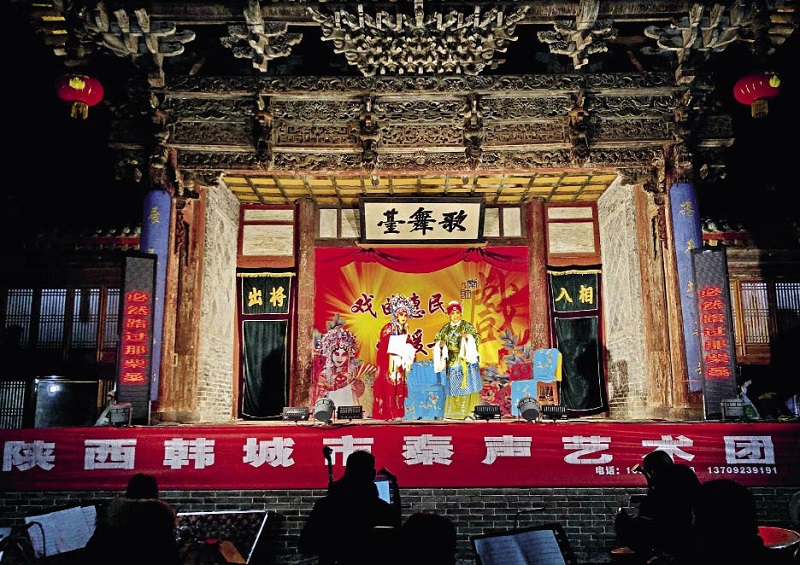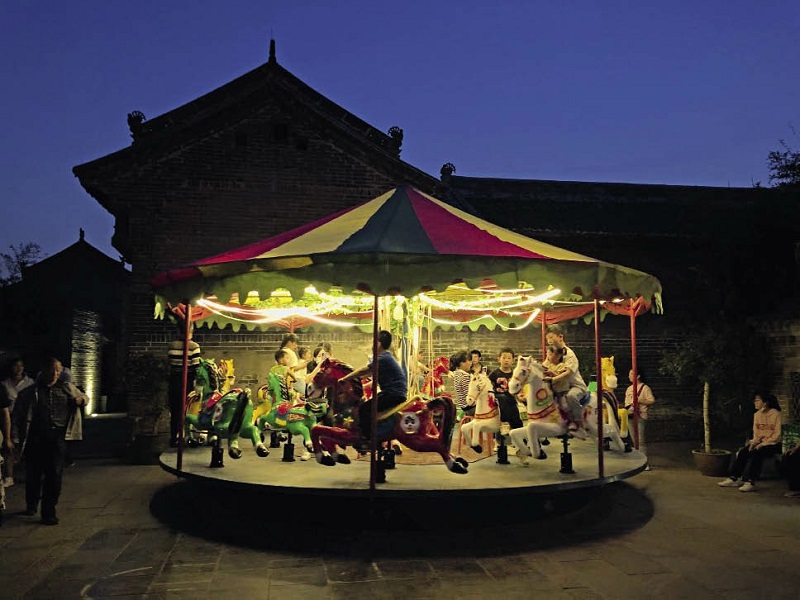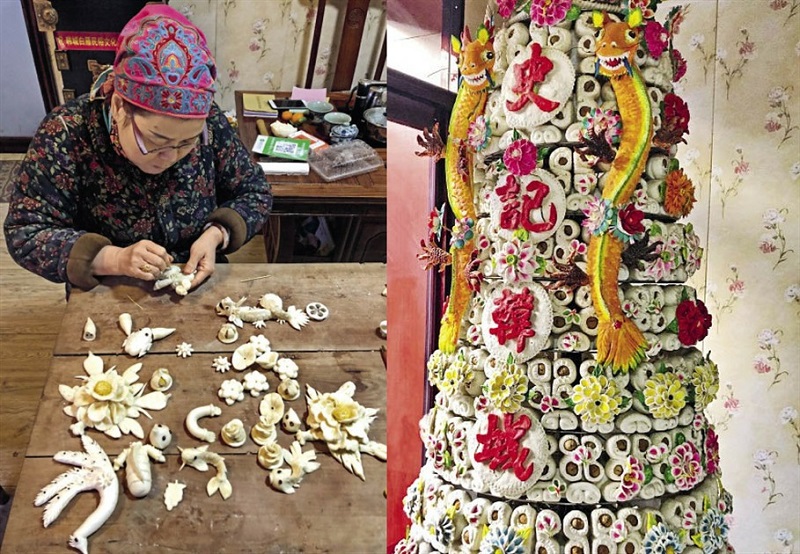
Along the time-honored quaint streets of Dangjia Village, the cobblestone alleys, gated residence of various styles, and masterfully designed quadrangle dwellings display the prosperity and glory of the city’s ancient past.
HANCHENG, a city in northwest China’s Shaanxi Province, is renowned as the hometown of Sima Qian, a legendary historian in China’s Western Han Dynasty (202 BC-AD 8) and author of the Records of the Grand Historian.
Also known in ancient times as “Longmen” or Dragon Gate, Hancheng was built during the Western Zhou Dynasty (1046-771 BC). It is part of the Guanzhong Plain urban agglomeration along the banks of the Yellow River. Throughout history, the city experienced much political turmoil and reconstruction. Various archaeological discoveries were made in the city, which include the ruins of vassal states in the Western Zhou Dynasty and large frescoes from the Song Dynasty (960-1279), all of which have added to the many stories this city has to tell.
An Unpretentious City of Historical Profundity
China has many ancient cities, but Hancheng is unique. Throughout its long history, the city has developed distinctive characteristics of unpretentiousness and profundity. It is one of the few ancient cities that have preserved the most complete and largest quantity of architecture from the Yuan Dynasty (1271-1368).
Jincheng Street is the main thoroughfare of Hancheng. The street dates back to the Ming and Qing dynasties (1368-1911), extending 1,000 meters from south to north. Along it are shops that have been well preserved from the Ming and Qing dynasties. The stores are a part of a two-storey building in a courtyard. The style was typical in ancient times in north China. The top floor of the store building was usually designated for storage, and the family of the business owner used the courtyard in the back for residence. The street is decorated with various kinds of beautiful carvings made of brick, wood, and rock. There are also special gates for horses, which were the main means of transportation for ancient Chinese. Each detail is full of history that is recounted with pleasure by locals.
At the end of Jincheng Street, there is a soaring golden pagoda overlooking a cluster of old temples and residences. Nestling in an ancient temple is the Hancheng Museum. It boasts a large and rich collection of cultural artifacts with ancient architecture and is a miniature view of the state-level historical and cultural city. A cluster of well-preserved traditional courtyard dwellings can also be seen from the soaring pagoda. Designed and laid out in an orderly manner, the classical courtyard dwellings in Hancheng are similar in style to those in Beijing, thus winning the city a nickname of “little Beijing.”

Shaanxi Opera performers on the stage of the City God Temple in the old city.
“Living Fossils” in Dangjia Village
Dangjia Village is located in the northeastern part of Hancheng and traces its historical roots back to the second year of the Zhishun Reign (1331) during the Yuan Dynasty. This village, with its cluster of ancient architecture, is a representative of the way people in Shaanxi Province lived in ancient times, and has been appreciated at home and abroad as a “treasure of human habitation” and “living fossil of how rural people of the Orient lived in ancient times.”
Upon entering Dangjia Village, the first sight is a weathered and time-honored cobblestone street, and residences with large gates of various sizes telling of the village’s prosperity and glory in years gone by. The location of the village was well chosen by ancestors. It is in a low-lying area shaped like a gourd. The terrain is uneven. To enter the village, visitors have to follow a windy path down a slope until it comes to a small bluestone walkway. At this point, they behold a large panoramic view of various kinds of structures including towers, temples, pagodas, pavilions, stone archways, ancient school buildings, family ancestral halls, watchtowers, and so on. Looking at the scene that is alive with rich ancient culture and artistic beauty, people feel like they are traveling back to the days of the Ming and Qing dynasties to witness the missing pages of ancient history.

Shaanxi Opera performers on the stage of the City God Temple in the old city.
Imprints of History
On the top of a mountain to the south of Hancheng City lies the Sima Qian Temple which was built in the fourth year of the Yongjia Reign (310) of the Western Jin Dynasty. The temple boasts a history of almost 1,700 years. In 1982, it was designated as a historical site under state protection, and in 2014, the site was rated a national AAAA tourist destination.
The scenic area welcomes visitors with a wooden archway that was rebuilt in the Qing Dynasty. Inscribed on the archway is six Chinese characters which state, “Sima Qian, Court Historian of the Western Han Dynasty.” Further up the hill lies the Taigong Temple followed by a fork in the road, ahead of which lie three temples on the southern slope of the mountain, namely Yuwang Temple, Zhangyao Temple, and Three Sages Temple. One route of the fork leads to another wooden archway dating back to the Yuan and Ming dynasties. The inscription on the archway states, “Great Admiration as for a High Peak.” It refers to the great moral character of Sima Qian. From that point, the pathway leads to another archway and 99 steps before finally culminating at the Sima Qian Temple. From the temple, the raging Yellow River can be seen in the east, Liangshan Mountain in the west, and the ancient remains of the Great Wall during the Wei Kingdom (403 BC-AD 225), and bodies of running water in the north.
In recent years, the “Sima Qian Worship Ceremony” has become a major event attracting visitors to the scenic area. This service, which has been preserved for thousands of years, is filled with cultural value and stands as a cultural symbol and landmark of Hancheng City. It has attracted many tourists and become unique appeal of the site.
Longmen Crossing, or Dragon Gate Crossing, located 30 kilometers north of the city, is another renowned tourist attraction. The water of the Yellow River rushes out of the escarpments, forming a gorge like a giant gate. It was said that only the dragon could fly over the gate, thus giving the crossing the name Longmen or “dragon gate.” It was also said that the gorge was carved by Yu the Great of the Xia Dynasty (2100-1600 BC) to tame the flooding water, giving it yet another name of Yu Gate.
The ancient Longmen Crossing was of strategic importance as a transportation hub connecting Shaanxi and neighboring Shanxi. Travelling about four kilometers upstream from Longmen, visitors arrive at Shimen, where the river measures only 60 meters in width. It is the narrowest part of the Yellow River. Another 38 kilometers upstream leads to the famous roaring Hukou Waterfalls.

Wang Lizhen, an inheritor of the intangible cultural heritage of Hancheng flower buns, is making buns of different shapes.
Unforgettable Flavors of Hancheng
To really experience a place, one must learn about its culture and understand the vicissitudes of the people there. Modern Chinese poet and novelist Ye Linzhi once described Hancheng in the following way. “The city of Hancheng is full of stories. From the traditional drumming, flower buns, to mutton noodle soup, all of these features exhibit the honesty, beauty, and down-to-earth character of local people. Visitors can even see performances of Shaanxi Opera staged by people in the street. Walking through the time-honored old city or the newly-built city, touching the walls and feeling the texture that has been engraved by time, or sitting on the centuries-old stools that can been seen everywhere in the ancient city streets, one cannot help but be awed by the protected civilization and human development that has continued in this city for centuries.”
Through the vicissitudes of time, the city has enjoyed a lengthy continuity to accumulate a rich expression of culture, human sentiments, and natural beauty, which is exhibited in its ancient streets, ancient villages, ancient pagodas, and quaint bridges. The list goes on and on of everything connecting to the past.
Hancheng not only gives visitors a nostalgic feeling of ancient culture and history, but also offers a variety of mouth-watering delicacies ranging from wonton soup to mutton noodle soup, baked sesame-seed cakes, spicy unleavened dough, and honey-flavored traditional Chinese rice pudding. In recent years, the city has developed the industry of growing prickly ash. With this industry, local people have created a lineup of prickly ash products that include prickly ash sprouts, prickly ash beer, prickly ash skin care products, prickly ash yogurt, and so on. Yogurt made from prickly ash is the most popular. The flavor of this yogurt is not strange, as one may assume. It actually leaves a lasting pleasant flavor in the mouth of the eater through its mixture of sour and sweet flavors. Another local delicacy worth mentioning is the sweet flower bun, which is made from a delicious combination of flour, walnuts, dates, and sesame seeds.
Over the past years, Hancheng has been working hard to upgrade its scenic spots. While launching new tourist products, it has been moving even faster in improving a tourism facilitation system and expanding its transportation network, so as to provide tourists with easier-to-access and affordable travel experiences. On October 11, 2020, the first high-speed train from Xi’an, capital of Shaanxi, to Hancheng was put in operation, shortening the travel time between the two cities to less than two hours. In the future, the opening of inter-city railway services between Xi’an and Hancheng will make the city better accessible to tourists.
Throughout centuries, kingdoms and dynasties rose and fell, but a civilization has been preserved. Hancheng, a city of historical profundity, has a lot to offer. Strolling along its ancient streets, visitors will find themselves transported back to ancient times and steeped in a civilization that has weathered the test of time.
SONG CAIQUN is a travel columnist.









